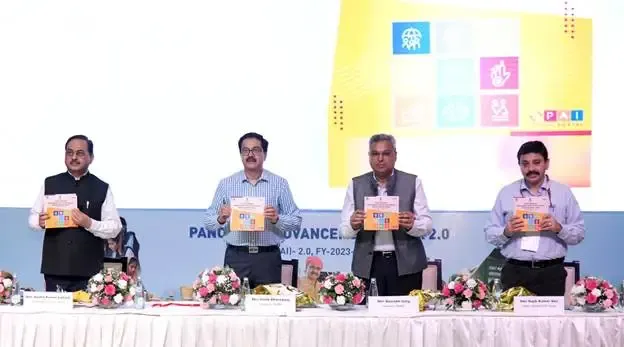What Does the Launch of the Panchayat Advancement Index 2.0 Mean for Grassroots Governance?

Synopsis
Key Takeaways
- The Panchayat Advancement Index (PAI) 2.0 portal has been launched to enhance grassroots governance.
- It enables systematic assessment of over 2.5 lakh Gram Panchayats.
- PAI 2.0 builds on the foundation laid by Version 1.0, improving functionality and usability.
- Accurate data entry is crucial for effective governance and development.
- The initiative aligns with India's Sustainable Development Goals.
New Delhi, May 26 (NationPress) In an effort to empower panchayats to systematically evaluate and enhance their performance in crucial governance and service delivery areas, the Centre has introduced the Panchayat Advancement Index (PAI) 2.0 portal.
The PAI is a performance assessment framework crafted by the Ministry of Panchayati Raj, aimed at tracking over 2.5 lakh Gram Panchayats across nine themes corresponding with the Localisation of Sustainable Development Goals (LSDGs).
While PAI Version 1.0 laid the groundwork by covering data from 2.16 lakh Gram Panchayats across 29 States/UTs, PAI Version 2.0 signifies a substantial enhancement in functionality, efficiency, and user-friendliness.
“The upgrade from PAI 1.0 to 2.0 embodies a concentrated improvement of the framework, offering a more refined and practical collection of indicators and data points aimed at enhancing usability and dependability while maintaining thematic thoroughness,” stated the ministry.
Vivek Bharadwaj, Secretary of the Ministry of Panchayati Raj, highlighted the transformative potential of the PAI 2.0 in assisting panchayats to systematically evaluate and enhance their performance in vital governance and service delivery sectors.
Referencing Prime Minister Narendra Modi's vision for Aspirational Districts and Aspirational Blocks, he remarked, “We must now carry this spirit forward in our Panchayats. Recording precise data does not merely entail counting; it contributes to the nation’s transformation.”
He emphasized that the PAI is more than a data collection mechanism; it is a tool to institutionalize transparent, accountable, and performance-driven Panchayat-level governance.
Bharadwaj encouraged on-ground functionaries to input accurate data into the PAI 2.0 portal, which will provide a comprehensive perspective for the holistic development of India.
“The PAI data forms the foundation for equitable development, transparency, and participatory governance,” he added.
Saurabh Garg, Secretary of the Ministry of Statistics and Program Implementation, remarked, “India’s availability of SDG data has surged from 55 percent to nearly 95 percent over the past five years.”
He underscored how the PAI framework, through enhanced standardization, harmonization, and visualization, propels the national objective of inclusive, outcome-driven governance.









